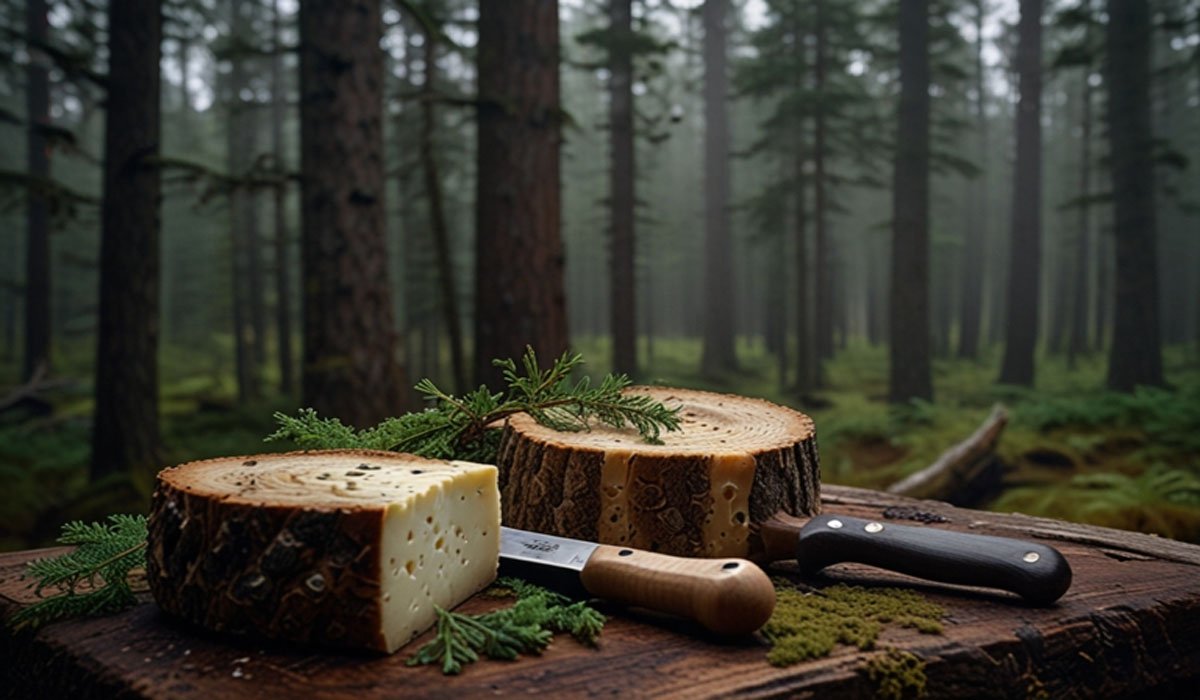Picture this: You’re deep in a Scandinavian forest, the air crisp with pine and damp earth. A hunter returns, not just with game birds, but with a small, pungent wheel wrapped in birch bark. This isn’t your local cheesemonger’s latest find. This is grouse cheese – a culinary enigma whispered about in foraging circles and Nordic folklore, a dairy-less “cheese” born from the forest itself. Sounds like something from a Viking saga? It’s a very real, albeit incredibly rare, tradition clinging to existence. Buckle up; we’re diving into the wild world of this unique forest delicacy.
Your Guide to the Forest’s Most Unusual “Dairy”
Forget cows, goats, or sheep. Grouse cheese represents an entirely different frontier of fermentation and preservation. It’s not cheese in the conventional sense, but a product of ingenuity born from necessity, utilizing an unexpected part of the grouse bird. Let’s navigate this fascinating terrain.
What Exactly Is Grouse Cheese? (Hint: It’s Not From Udder)
The secret lies not in milk, but in the crop of the grouse. The crop is a pouch in the bird’s throat where food is stored before digestion. Hunters discovered that the partially fermented, grain-filled contents of the crop, carefully removed and processed, could be transformed. Through meticulous cleaning, seasoning (often with juniper berries, wild herbs, or salt), and pressing, this mass undergoes further fermentation and drying. The result? A dense, intensely flavored paste or small wheel – grouse cheese. It’s a primal form of charcuterie, a testament to nose-to-tail utilization long before the term was trendy.
Why Would Anyone Make Cheese From a Bird’s Crop? The Hunter’s Logic
This practice stems from deep-rooted hunter-gatherer traditions, particularly in Northern Europe (Scandinavia, Russia, the Baltics):
- Zero Waste Ethic: In harsh environments, every part of the animal held value. The crop contents were seen as a potential food source, not waste.
- Preservation Necessity: Before modern refrigeration, preserving meat and finding calorie-dense, non-perishable foods was critical. Fermenting and drying the crop created a long-lasting, nutrient-rich product.
- Unique Flavor Profile: Hunters discovered that the fermented grains and seeds, imbued with the bird’s natural enzymes and gut flora, developed complex, umami-rich, and often funky flavors prized as a delicacy or survival food.
- Cultural Heritage: It became a part of specific regional food cultures, passed down through generations, often shrouded in secrecy.
The Taste Test: What Does Grouse Cheese Really Taste Like?
Describing grouse cheese is challenging due to its rarity and variability. However, consistent themes emerge:
- Funky & Fermented: Expect a pronounced, earthy gaminess reminiscent of aged game meat or strong offal, layered with deep umami.
- Earthy & Nutty: Notes of the forest floor, mushrooms, and the nuts/seeds the grouse consumed (like lingonberries, juniper, pine nuts, or grains).
- Tangy & Sour: The natural lactic acid fermentation creates a distinct tanginess.
- Intensely Savory: A powerful, lingering savoriness that’s more condiment than snack.
- Texture: Dense, crumbly, and dry – often grated or shaved thinly over dishes.
Think of it as the wild ancestor of Vegemite or intensely aged salami – an acquired taste that packs a serious flavor punch.
Grouse Cheese vs. The World: A Flavor & Origin Comparison
| Feature | Grouse Cheese | Traditional Dairy Cheese (e.g., Aged Cheddar) | Modern Plant-Based “Cheese” |
| Base Ingredient | Fermented contents of a grouse’s crop | Animal milk (cow, goat, sheep) | Nuts (cashew, almond), Soy, Oils |
| Production | Traditional hunter-forager method | Controlled dairy farming & cheesemaking | Industrial food processing |
| Flavor Profile | Intensely gamey, funky, earthy, umami, tangy | Milky, buttery, nutty, sharp (varies) | Often mimics dairy; nutty, creamy |
| Texture | Very dense, dry, crumbly | Ranges from soft & creamy to hard & crumbly | Varies widely (soft to semi-hard) |
| Availability | Extremely rare, niche, regional | Widely available globally | Increasingly available |
| Primary Use | Condiment, flavor enhancer | Snack, cooking ingredient, table cheese | Snack, cooking, melting |
The Ethics & Ecology: A Delicate Balance
The existence of grouse cheese raises important questions:
- Sustainability: Grouse populations in many areas are carefully managed for hunting. Responsible, regulated hunting is generally considered sustainable. However, making cheese specifically incentivizes hunting these birds. Is demand for this niche product compatible with healthy grouse populations? Crucial consideration.
- Animal Welfare: While hunting practices vary, the focus is on utilizing the whole bird, aligning with ethical harvesting principles more than industrial farming. However, the concept itself can be challenging for some.
- Modern Palates & Access: Its extreme flavor and rarity make it inaccessible and unappealing to most. Is preserving this tradition important, or a relic best documented but not widely practiced?
Read also: grenblis Uncovered: The Superfood You Need to Know About
Can You Actually Try Grouse Cheese? (Spoiler: It’s Tough)
Finding authentic grouse cheese is like searching for truffles without a pig. Here’s the reality:
- Vanishing Tradition: Few practitioners remain. It’s primarily made in remote areas by individuals or very small communities keeping old traditions alive.
- No Commercial Production: You won’t find it in supermarkets or even most specialty cheese shops. Hygiene regulations and scale make commercial production virtually impossible.
- The Forager/Hunter Network: Your best (and perhaps only) chance is through connections within deep-rooted hunting or foraging communities in Scandinavia, the Baltics, or Russia. It’s often shared privately, not sold.
- Cultural Experiences: Some ultra-niche culinary adventures or cultural heritage events might offer a taste, prepared by traditional practitioners. Think exclusive, research-based expeditions, not your average food tour.
So, while the idea is captivating, experiencing genuine grouse cheese is a privilege afforded to very few.
Beyond the Novelty: Why Grouse Cheese Matters Today
Despite its obscurity, grouse cheese offers valuable lessons:
- Radical Resourcefulness: It challenges our modern concepts of food waste and edible ingredients, showcasing incredible historical ingenuity.
- Cultural Preservation: It represents a unique strand of intangible cultural heritage worth documenting and understanding.
- Flavor Exploration: It pushes the boundaries of what we consider “fermented food” and “savory flavor,” inspiring chefs and food scientists exploring novel fermentation techniques.
- Connection to Landscape: Its flavor is a direct, potent expression of a specific forest ecosystem and the diet of a wild bird – a true taste of terroir in its most primal form.
Your Forager’s Takeaways: Navigating the Grouse Cheese Legend
- It’s Not Dairy Cheese: Understand it as a unique fermented meat/byproduct product, a primal ancestor to charcuterie.
- Flavor is Extreme: Approach it with an open mind but expect powerful, challenging, gamey, funky, and umami sensations.
- Rarity is Real: Finding authentic grouse cheese requires deep connections or extraordinary luck within specific cultural pockets.
- Respect the Tradition & Ecology: If you ever encounter it, appreciate the skill, history, and ethical sourcing behind it. Support sustainable hunting practices if engaging with the tradition.
- Be Inspired, Not Necessarily a Consumer: Let it spark curiosity about historical food preservation, fermentation’s possibilities, and utilizing local wild resources thoughtfully.
Grouse cheese is less about becoming your next snack and more about a fascinating detour into humanity’s culinary past. It’s a reminder of the incredible lengths our ancestors went to survive and find flavor, a testament to the wild and often unexpected potential of the natural world. It’s a flavor forged in the forest, a secret kept by the trees and the hunters who walk beneath them.
Grouse Cheese: Unraveling the Forest Mystery (FAQs
Q1: Is grouse cheese actually made from milk?
A1: Absolutely not! That’s the big surprise. Grouse cheese is made from the fermented, cleaned contents of the bird’s crop (a throat pouch where food is stored before digestion). It’s a unique fermentation of grains, seeds, and berries the grouse ate.
Q2: What does grouse cheese taste like?
A2: Imagine concentrated gamey, forest-floor flavors – intense umami, earthiness, funk (like strong aged meat or offal), tang from fermentation, and notes of whatever the grouse consumed (juniper, pine nuts, berries). It’s powerful and an acquired taste!
Q3: Can I buy grouse cheese online or in stores?
A3: It’s incredibly unlikely. Authentic grouse cheese is a vanishing tradition made in tiny quantities by individuals in specific Nordic/Baltic/Russian regions. It’s rarely sold commercially due to scale, regulations, and its niche nature.
Q4: Is making or eating grouse cheese ethical?
A4: This is complex. It relies on hunting grouse. If hunting is sustainable and regulated, and the whole bird is used (which this practice supports), it aligns with ethical harvesting principles. However, creating demand for this specific product solely for its novelty could raise ecological concerns. Understanding the source is crucial.
Q5: Why would anyone make cheese from a bird’s crop?
A5: Historically, it was pure necessity and zero-waste ingenuity. Hunters in harsh northern climates utilized every part of the animal. They discovered the fermented crop contents could be preserved as a calorie-dense, long-lasting food source, developing unique flavors prized in those cultures.
Q6: Is grouse cheese safe to eat?
A6: When prepared traditionally by experienced practitioners using meticulous cleaning and fermentation/drying methods, it has been consumed safely for generations. However, improper preparation carries risks like any fermented meat product. Its rarity means modern food safety testing is virtually non-existent. Caution and sourcing knowledge are paramount.
Q7: Does grouse cheese have any modern relevance?
A7: Beyond cultural preservation, it inspires! It showcases radical historical food innovation, challenges our ideas of “edible,” and pushes boundaries in fermentation science. It’s a fascinating case study in wild terroir and sustainable (if niche) resource use.
You may also like: The Rise of Süberlig: Revolutionizing Food with Taste, Health, and Sustainability











